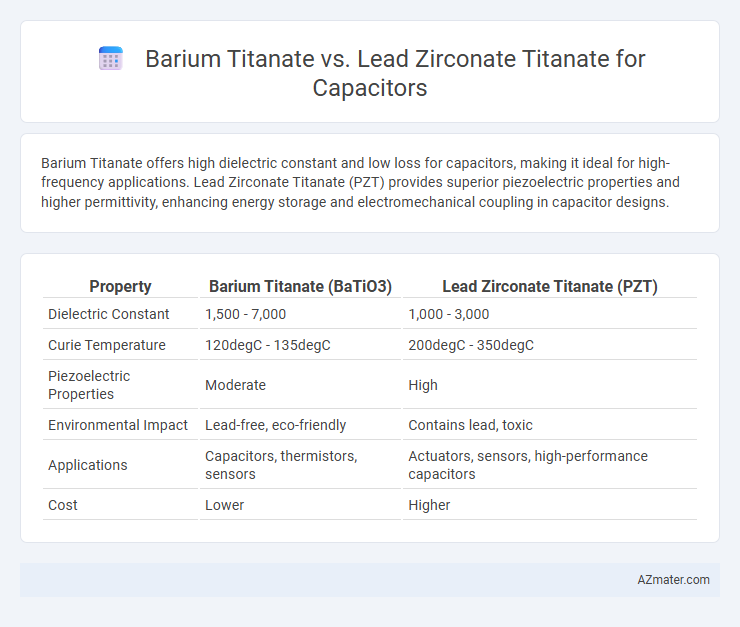Barium Titanate offers high dielectric constant and low loss for capacitors, making it ideal for high-frequency applications. Lead Zirconate Titanate (PZT) provides superior piezoelectric properties and higher permittivity, enhancing energy storage and electromechanical coupling in capacitor designs.
Table of Comparison
| Property | Barium Titanate (BaTiO3) | Lead Zirconate Titanate (PZT) |
|---|---|---|
| Dielectric Constant | 1,500 - 7,000 | 1,000 - 3,000 |
| Curie Temperature | 120degC - 135degC | 200degC - 350degC |
| Piezoelectric Properties | Moderate | High |
| Environmental Impact | Lead-free, eco-friendly | Contains lead, toxic |
| Applications | Capacitors, thermistors, sensors | Actuators, sensors, high-performance capacitors |
| Cost | Lower | Higher |
Introduction: Barium Titanate vs Lead Zirconate Titanate
Barium Titanate (BaTiO3) and Lead Zirconate Titanate (PZT) are prominent dielectric materials used in capacitors, known for their high permittivity and ferroelectric properties. BaTiO3 offers excellent temperature stability and eco-friendly characteristics, making it ideal for multilayer ceramic capacitors (MLCCs). PZT exhibits superior piezoelectric coefficients and tunable dielectric constants, widely applied in sensors, actuators, and high-performance capacitors.
Crystal Structure and Composition
Barium Titanate (BaTiO3) features a perovskite crystal structure characterized by a tetragonal phase that significantly contributes to its high dielectric constant and ferroelectric properties. Lead Zirconate Titanate (PZT), composed of Pb(Zr_xTi_1-x)O3, exhibits a complex perovskite structure with a morphotropic phase boundary that enhances piezoelectric and dielectric performance through the coexistence of rhombohedral and tetragonal phases. The substitution of lead and zirconium in PZT's composition results in superior dielectric permittivity and electromechanical coupling compared to the lead-free Barium Titanate, making PZT highly effective for advanced capacitor applications.
Dielectric Properties Comparison
Barium Titanate (BaTiO3) exhibits high dielectric constant values typically ranging from 1200 to 6000, making it suitable for capacitors requiring strong permittivity and temperature stability. Lead Zirconate Titanate (PZT) offers a higher dielectric constant, often between 1000 and 5000, combined with superior piezoelectric properties but with increased dielectric loss compared to BaTiO3. BaTiO3 generally demonstrates lower dielectric loss and better aging stability, whereas PZT provides enhanced tunability and electromechanical coupling, impacting capacitor performance in applications where these characteristics are critical.
Ferroelectric Characteristics
Barium titanate (BaTiO3) exhibits strong ferroelectric properties with a high dielectric constant and excellent temperature stability, making it ideal for high-performance capacitors. Lead zirconate titanate (PZT) offers superior piezoelectric response and higher remnant polarization, enhancing energy storage and sensitivity in ferroelectric capacitors. While BaTiO3 is preferred for environmentally friendly applications, PZT remains dominant in industries requiring robust ferroelectric characteristics and tunability.
Capacitance Performance Analysis
Barium Titanate (BaTiO3) exhibits high dielectric constant values typically ranging from 1200 to 1600, making it suitable for capacitors requiring moderate capacitance with excellent temperature stability. Lead Zirconate Titanate (PZT) generally offers higher dielectric constants between 300 to 1500 but excels in piezoelectric properties, which can influence capacitance under mechanical stress, thereby affecting performance in dynamic environments. For static capacitance performance, BaTiO3 capacitors provide more stable and consistent capacitance values, while PZT capacitors are favored in applications requiring tunable or variable capacitance due to their ferroelectric characteristics.
Temperature Stability and Reliability
Barium Titanate exhibits superior temperature stability in capacitors, maintaining consistent dielectric properties across a broad temperature range due to its high Curie temperature. In contrast, Lead Zirconate Titanate (PZT) offers enhanced reliability under high electric fields but can experience dielectric aging and reduced stability at elevated temperatures. For applications requiring robust temperature performance and long-term reliability, Barium Titanate capacitors are preferred, while PZT capacitors excel in high-performance piezoelectric and actuator roles.
Environmental and Safety Considerations
Barium titanate (BaTiO3) is favored for capacitors due to its lead-free composition, reducing environmental toxicity and health hazards compared to lead zirconate titanate (PZT), which contains lead and poses disposal challenges and potential lead poisoning risks. Barium titanate's non-toxicity supports compliance with regulations such as RoHS, making it a safer choice for electronic manufacturing and consumer products. PZT, while exhibiting superior piezoelectric performance, requires stringent handling, recycling, and waste treatment protocols to mitigate its environmental impact and ensure workplace safety.
Manufacturing and Processing Techniques
Barium Titanate (BaTiO3) and Lead Zirconate Titanate (PZT) differ significantly in their manufacturing and processing techniques, impacting capacitor performance and application. BaTiO3 ceramics undergo solid-state reaction sintering at high temperatures around 1300degC, demanding precise control to achieve uniform grain size and phase purity essential for dielectric properties, while PZT utilizes mixed oxide or sol-gel methods with sintering typically between 850degC and 1200degC, allowing better compositional control and enhanced piezoelectric performance. Processing PZT requires careful lead oxide volatilization control to maintain stoichiometry, whereas BaTiO3 manufacturing emphasizes minimizing oxygen vacancies to reduce dielectric losses, influencing scalability and cost in capacitor production.
Application Suitability in Modern Capacitors
Barium Titanate (BaTiO3) is preferred in modern capacitors for its high dielectric constant and temperature stability, making it ideal for multilayer ceramic capacitors (MLCCs) used in consumer electronics and automotive applications. Lead Zirconate Titanate (PZT) offers superior piezoelectric properties and higher dielectric permittivity, which suits it for applications requiring precise actuation and sensing, such as in resonators and MEMS devices. The environmental concerns and lead content in PZT limit its use in general capacitor applications, where BaTiO3 provides a more eco-friendly solution with robust performance.
Future Trends in Capacitor Materials
Barium Titanate (BaTiO3) and Lead Zirconate Titanate (PZT) are pivotal in developing advanced capacitors, with BaTiO3 favored for lead-free, environmentally friendly applications, while PZT offers superior piezoelectric properties. Future trends emphasize enhancing BaTiO3's dielectric constant and thermal stability through nanostructuring and doping to rival PZT's performance without toxic lead content. Research also targets integrating these materials into flexible, high-energy-density capacitors for next-generation electronics and renewable energy systems.

Infographic: Barium Titanate vs Lead Zirconate Titanate for Capacitor
 azmater.com
azmater.com